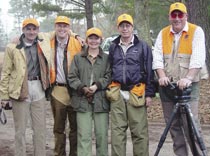
|
The Gazette
Texas Blues • Tennessee Reds • Southern Bob Whites |
|
|
Dee asks if you are ready, then
he commands "Flush Em Out". Well, I can assure you, this
brings a whole new dimension to Quail shooting. Spend a day at Dorchester pursuing pointers after Tennessee Reds and you'll come as close to shooting Wild Quail as you can get without having your own Plantation...it's a lot of fun and a lot less money! Thanks, Chuck and Charlie...see you in High Definition this Fall! Our last stop on our Quest for Quail took us to Brays Island, a private paradise of... Southern Bob Whites At Brays Island, I found myself riding on a picturesque, mule-drawn wagon, creaking along through some of the prettiest Southern Bob White Quail habitat I have ever seen. We were accompanied by a brace of outriders - English pointers, quartering through the manicured pine forest cover ahead like WWII fighter planes guiding a bomber back from a mission.  This is old-fashioned, traditional Southern Plantation Quail shooting at its best. This is the sport as it has always been - the preserve of the wealthy - as formal and elegant as a Driven Grouse or Pheasant Shoot back in England. I was fortunate enough to be the guest of Perry Harvey, and by extension, the other owners of Brays Island, a 5,000-acre Sportsman's Paradise, where over 3,750 acres are in conservation easements, and the residents are entirely devoted to outdoor pursuits. There were many such Plantations at the turn of the Century, but the financial pressures of operating a Plantation for the sole purpose of offering Quail hunting for the family or guests at weekends and holidays for a few months of the year were substantial! |
This
meant that many Plantation owners had to diversify their investments
into more profitable areas like cash crops, which required larger
fields, fertilization, herbicides and pesticides or they got into
commercial timber farming or property development. Today, many of these fine old Plantations have been broken up and many of the hunting opportunities have simply disappeared. Brays Island is one of the unique exceptions and here everything is geared towards preserving that Turn of the Century experience.  Full credit goes to the hard-working and knowledgeable team that cultivates this pristine habitat, manages the kennels, trains and runs the dogs and not to forget, keeps up the mules, wagons and horses, all of which goes to maintain this Southern Quail Plantation hunting heritage. At a sudden movement, the mounted guide holds his hat aloft. There's that thrilling sight of pointers locked on scent. Then comes the swift descent from the wagon and horses, shotguns are deftly removed from scabbards and loaded, the hunters moving into the positions indicated by the guide. "Are you ready, gentlemen?" On our nod of agreement - the flush! That buzz of wing beat and swirl of feather, that always makes your heart race and blood pound! You move, the mount and swing, choosing your bird from the flashing, bursting covey, you lock on and squeeze the trigger. A puff of feathers on the first barrel, but the bird's still flying strong! Keep the swing going and squeeze off the second trigger. Then that magic moment when the Quail seems to fly into a wall and drop! The retrieve, with a hen Bob White brought to hand! As they say in the South "That is gooder ' n grits!" Page 7 |
||||
